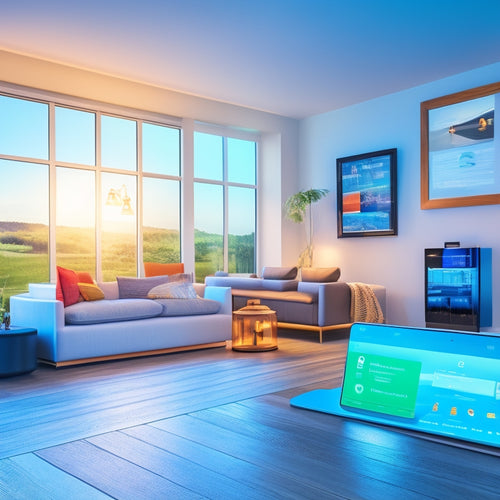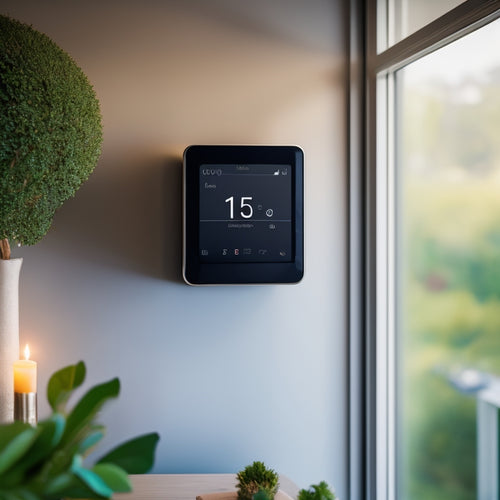
7 Best Energy-Saving Air Purifiers for Green Homes
Share
You're likely looking for air purifiers that not only clean the air but also contribute to a more sustainable future. With Energy Star certified models using up to 80% less energy, it's now possible to breathe easy while reducing your carbon footprint. Top-rated options like the Levoit LV-H132 and Dyson Pure Cool Link boast smart features, eco-friendly filters, and low power consumption. As you investigate the best energy-saving air purifiers for your green home, you'll find compact designs, whisper-quiet operation, and balance between air quality improvement and environmental responsibility - and there's more to uncover as you move forward in your search for the perfect eco-friendly air purifier.
Key Takeaways
- Look for air purifiers with Energy Star certification, ensuring compliance with energy efficiency standards and reducing energy costs.
- Eco-friendly purification methods, like biodegradable filters and reusable cartridges, minimize environmental impact and waste.
- Compact, low-wattage air purifiers (20-50 watts) are ideal for small spaces, providing effective air cleaning while saving energy.
- Smart features, such as auto-mode and real-time air quality reports, optimize energy consumption and performance in energy-saving air purifiers.
- Renewable energy solutions, like solar power, can be integrated into air purifiers, reducing reliance on non-renewable sources and contributing to a cleaner future.
Energy-Efficient Air Purification Solutions
Many modern air purifiers on the market prioritize energy efficiency, recognizing that a significant portion of their users will be running them continuously.
You're likely one of them, seeking a balance between clean air and a clear conscience about your energy consumption. Look for air purifiers with smart filtration systems that optimize airflow and minimize waste.
By adopting renewable energy solutions, such as solar power for EV charging, you can reduce your reliance on non-renewable power and minimize your carbon footprint. Some models even integrate with renewable energy sources, reducing your reliance on non-renewable power.
By choosing an energy-efficient air purifier, you'll not only reduce your carbon footprint but also save money on your utility bills.
As you investigate your options, consider the long-term benefits of an eco-friendly air purifier that aligns with your values and promotes a healthier, more sustainable lifestyle.
Top Rated Air Purifiers for Homes
Since you're committed to creating a healthier indoor environment, you're likely keen to investigate the top-rated air purifiers designed specifically for homes.
As you consider your options, it's crucial to think about the broader context, including the role that solar-powered EV charging stations can play in reducing our carbon footprint solar-powered charging solutions.
To help you make an informed decision, here are some of the best options:
-
Levoit LV-H132: A compact and energy-efficient air purifier suitable for small to medium-sized rooms.
-
Dyson Pure Cool Link: A smart air purifier that provides real-time air quality reports and can be controlled remotely using an app.
-
Honeywell HPA300: A multi-room solution that captures 99.97% of particles as small as 0.3 microns, making it ideal for larger homes.
- Coway AP-1512GA: A high-performance air purifier with a built-in ionizer and eco-mode for energy efficiency, which can help reduce operational costs and promote energy independence, much like commercial solar charging systems.
Green Technology for Clean Air
When it comes to maintaining clean air in your home, you're likely looking for solutions that not only purify the air but also minimize their impact on the environment.
That's where green technology for clean air comes in, focusing on essential features that promote eco-friendly purification methods.
By integrating renewable energy into your air purification system, you can reduce your carbon footprint and create a healthier environment.
Additionally, solar power can be used to charge electric vehicles, leading to a cleaner and more sustainable future.
Clean Air Essentials
You deserve to breathe easy, and that's where clean air essentials come in. Enjoying the clean air benefits in your home is vital for a healthy and comfortable living space.
Indoor air quality can greatly impact your overall well-being, and it's important to prioritize it. By adopting sustainable practices, such as shifting to solar-powered vehicles, we can reduce our carbon footprint and contribute to cleaner air.
Additionally, regular inspections and maintenance of solar panels can guarantee peak energy production and minimize environmental impact.
- Air Purifiers: Remove pollutants and allergens from the air, leaving it fresh and clean.
- Ventilation Systems: Allow fresh air to circulate and stale air to escape, maintaining a healthy balance.
- Air Quality Monitors: Track and monitor indoor air quality, providing useful observations for improvement.
- Natural Air Fresheners: Use natural alternatives to harsh chemicals, promoting a healthier indoor environment.
Eco-Friendly Purification Methods
Beyond the clean air essentials, embracing eco-friendly purification methods takes your commitment to a healthier indoor environment to the next level.
You're not just removing pollutants - you're doing it sustainably. Look for air purifiers that incorporate biodegradable filters, reducing waste and minimizing environmental impact.
As the shift to EVs is a vital step towards effective Climate Action, adopting eco-friendly purification methods can also contribute to a cleaner environment.
Solar powered purifiers are another revolutionary solution, utilizing renewable energy to clean your air. This means you can breathe easy, knowing you're not contributing to climate change.
By choosing eco-friendly purification methods, you're creating a healthier home and a healthier planet.
Make the switch to green technology for clean air, and experience the freedom that comes with living in harmony with the environment.
Sustainable Air Quality
Air quality control systems, an essential component of sustainable living, have undergone a significant change with the integration of green technology.
You now have more options to breathe cleaner air while reducing your carbon footprint.
To achieve sustainable air quality, consider the following:
-
Indoor plants: They're natural air purifiers and can thrive in low-light conditions, making them perfect for rooms with limited sunlight.
-
Air circulation: Guarantee good airflow by opening windows, using fans, or installing vents to remove stale air and bring in fresh air.
-
Energy-efficient air purifiers: Look for devices with low wattage and high CADR (clean air delivery rate) to remove pollutants without consuming excessive energy.
- Regular maintenance: Clean or replace filters regularly to guarantee your air purifier works efficiently and effectively.
Low Power Air Purifier Options
Several low power air purifier options are available for those who want to minimize their energy consumption without compromising on air quality.
You'll find compact designs that fit neatly into small spaces, perfect for apartments or rooms with limited floor area. These energy-efficient air purifiers often feature whisper quiet operation, ensuring you can enjoy clean air without disruptions.
Look for units with low wattage ratings, usually around 20-50 watts, which can greatly reduce your energy bills. Some models also come with auto-mode features that adjust fan speed according to pollutant levels, further optimizing energy usage.
Eco-Friendly Air Quality Control
Your pursuit of eco-friendly air quality control doesn't have to stop at energy-efficient air purifiers. You can take it to the next level by incorporating natural and sustainable methods to improve indoor air quality.
Here are some eco-friendly air quality control tips:
-
Indoor plants: Add some greenery to your space to naturally purify the air. Some plants like peace lilies and spider plants are known to remove toxins and pollutants.
-
Improve air circulation: Open windows and doors to let fresh air in and stale air out. This simple act can go a long way in maintaining good air quality.
-
Use natural air fresheners: Ditch chemical-based air fresheners and opt for natural alternatives like essential oils or open boxes of baking soda.
- Reduce air pollution sources: Identify and eliminate sources of air pollution in your home, such as strong chemicals or cleaning products, to maintain a healthier indoor environment.
Sustainable Indoor Air Solutions
You're looking for air purifiers that not only clean the air but also help reduce your environmental impact.
Sustainable indoor air solutions focus on eco-friendly filter options that minimize waste and reduce the need for frequent replacements.
Eco-Friendly Filter Options
The air purifier's filter is an essential component in maintaining a healthy indoor environment, and opting for eco-friendly filter options can greatly reduce the device's ecological footprint.
When choosing an air purifier, you'll want to evaluate filters that are gentle on the planet. Here are some eco-friendly filter options to look for:
-
Biodegradable filters: Made from natural materials, these filters can easily decompose, reducing waste and minimizing environmental impact.
-
Reusable cartridges: These filters can be washed and reused multiple times, reducing the need for frequent replacements and the waste that comes with them.
-
Activated carbon filters: These filters are made from natural materials and can be recycled or repurposed at the end of their life cycle.
- Antimicrobial filters: These filters use natural antimicrobial properties to eliminate bacteria and viruses, reducing the need for chemical-based solutions.
Natural Air Quality Boost
Some people might think that maintaining good indoor air quality requires a constant supply of artificial air fresheners and dehumidifiers, but this couldn't be further from the truth.
You can enhance indoor air quality naturally without relying on artificial solutions. Natural ventilation is key - open your windows and doors to let fresh air in and stale air out.
Another effective way to purify the air is by bringing the outdoors in - literally. Indoor plants like peace lilies, spider plants, and aloe vera are known to remove pollutants and toxins from the air.
Low-Carbon Footprint Design
Air purifiers with a low-carbon footprint design are an essential component of sustainable indoor air solutions.
You want to guarantee that the air purifier you choose not only cleans the air but also reduces its impact on the environment. When shopping for an air purifier, look for devices made with sustainable materials and designed with energy conservation in mind.
Here are some key features to take into account:
- Energy Star certification: verifies the air purifier meets energy efficiency standards.
- Recyclable materials: reduces waste and supports a circular economy.
- Low power consumption: minimizes energy usage and saves you money.
- Long-lasting filters: reduces replacement frequency and waste generation.
Environmentally Friendly Air Purifiers
Harmony with nature is paramount in today's eco-conscious world, and your quest for clean air shouldn't come at the expense of the planet.
When choosing an air purifier, you want one that not only cleans the air but also minimizes its impact on the environment. Look for environmentally friendly air purifiers made with sustainable materials that reduce waste and conserve natural resources.
These eco-friendly models often incorporate air purification innovations that maximize efficiency while reducing energy consumption.
Frequently Asked Questions
Can Air Purifiers Also Remove Unpleasant Odors From the Air?
Did you know 75% of Americans live with some form of indoor air pollution? You'll be relieved to know that air purifiers can effectively remove unpleasant odors from the air, greatly improving your indoor air quality through advanced odor removal technology.
Do Energy-Efficient Air Purifiers Sacrifice Cleaning Performance?
You might wonder if energy-efficient air purifiers compromise on cleaning performance, but fear not - modern cleaning technology guarantees that eco-friendly models still capture 99.97% of particles, bacteria, and viruses, while using less energy and saving you money.
Are Air Purifiers With HEPA Filters More Energy-Hungry?
You'll find that air purifiers with HEPA filters don't necessarily guzzle more energy; their filter efficiency often offsets increased energy consumption, but it's crucial to check the unit's overall design and wattage to minimize its impact on your energy bill.
Can I Use an Air Purifier in a Small, Enclosed Space Safely?
You can safely use an air purifier in a small, enclosed space if you monitor air quality and guarantee good ventilation, as a purifier's effectiveness depends on space size, airflow, and filter type, not the space itself.
Do Air Purifiers Require Frequent Filter Replacements?
Fasten your seatbelts, folks! You'll be thrilled to know that air purifiers don't need frequent filter replacements. Typically, filters last 3-6 months, but with proper maintenance tips, like cleaning and dusting, you can extend the filter lifespan, saving you time and cash.
Related Posts
-

10 Best WiFi Outlets for Tracking Home Energy Usage
You can optimize your home's energy usage with the right WiFi outlets, which provide real-time monitoring and control...
-

Smart Energy: Greener Homes With Connected Power Devices
You can control and optimize your energy consumption with smart energy devices, reducing your carbon footprint by up ...
-

7 Solar-Safe Window Solutions for Earth-Conscious Homeowners
As an earth-conscious homeowner, you're likely keen to find solar-safe window solutions that align with your values. ...


